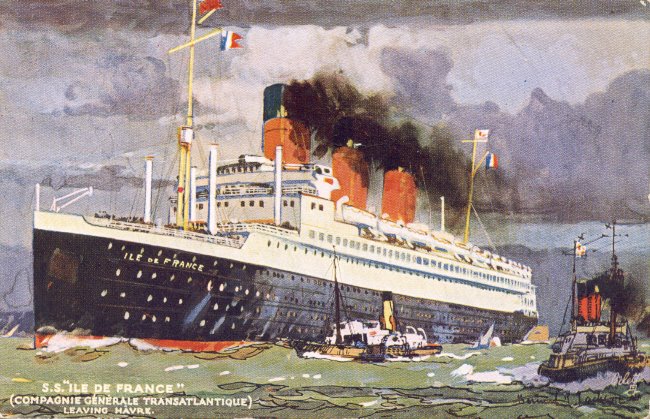Like many of the French Line's great passenger ships, Ile de France was
built by Chantiers et Ateliers Saint Nazaire. When she was launched in
1926, she was CGT's largest ship and the sixth largest in the world.
Her maiden voyage on 22 June 1927 was from Le Havre to New York by way
of Plymouth. In July 1928, a seaplane catapult was installed at the
ship's stern; beginning in August of that year, a seaplane took off when
Ile de France was within 500 miles of port, to cut the mail delivery
time by one day. This service ended in October 1930 and the catapult
was removed.
Laid up in New York when World War II began, Ile de France returned
home, but to Marseilles rather than Le Havre, in May 1940 and was on a
trooping mission to Indochina when France fell in June 1940. She was
then taken over by the British and served as a troopship, under Cunard
management, for the balance of the war. She reverted to French control
(but still under Cunard management) in September 1945, and served
another year as a troop and repatriation ship before being returned to
CGT in February 1946.
Her postwar career for CGT began in October 1946 on an austerity service
from Cherbourg to New York. A two year overhaul was begun in April
1947. The most noticeable change was the reduction of her funnels from
three to two. The last two cards on this page shows her as she appeared
after this work was completed. She returned to service on her old Le
Havre-New York route in July 1949.
In 1956, Ile de France rescued some 750 of the passengers from Andrea
Doria after he collision with Stockholm. Two years later she was laid
up and then sold for scrapping in Japan. Renamed Furanzu Maru for the
journey to Japan, she became a movie star on her way to the breakers,
being used under the name Claridon in the movie "The Last Voyage". Once
filming was completed, she was taken to Osaka and scrapped in 1959.
Sources: Haws' Merchant Fleets; Bonsor's North Atlantic Seaway



